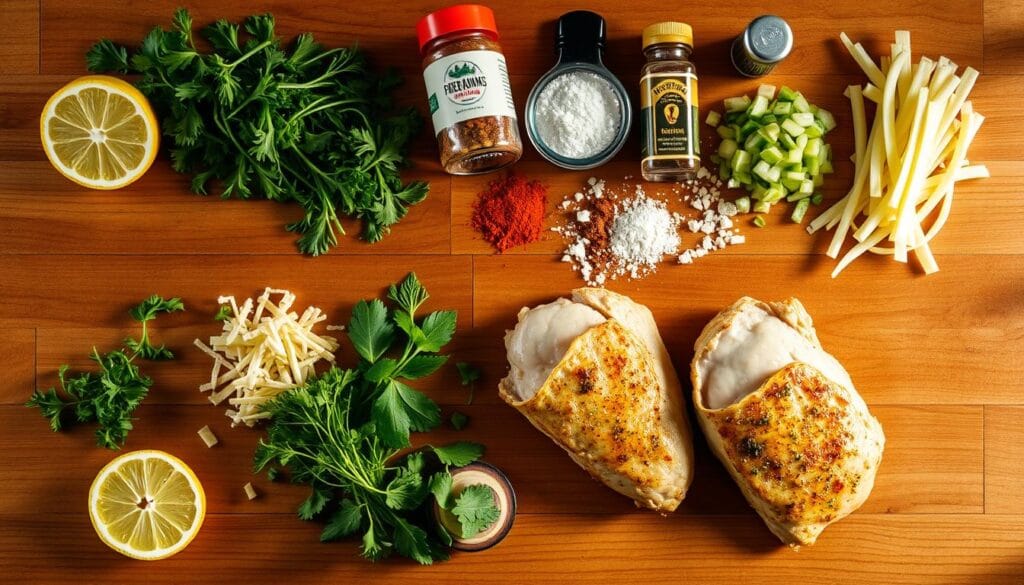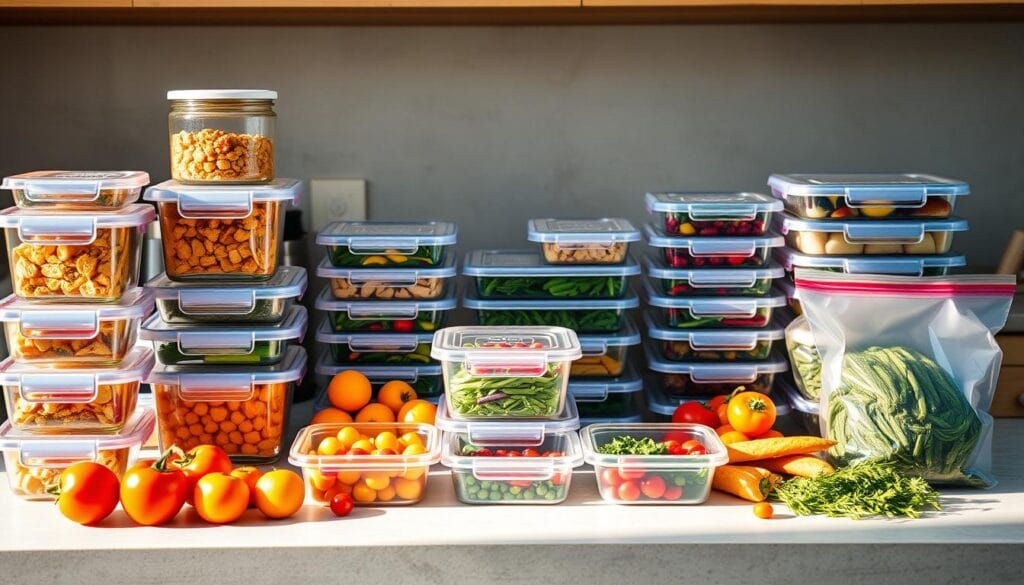Ever crave a meal that wraps you in warmth like your favorite blanket? Picture this: tender, golden-brown poultry blanketed in rich gravy, served alongside fluffy mashed potatoes. It’s the kind of dish that feels like a hug on a plate—without the guilt of traditional comfort foods.
This recipe proves you don’t need to choose between flavor and nutrition. Using a special cooking method, we’ve kept each serving under 450 calories while preserving that soul-satisfying taste. The secret lies in layering spices and simmering techniques that create restaurant-quality depth in your own kitchen.
Perfect for weeknights or casual gatherings, this meal serves four with minimal prep. We’ll show you how to transform simple ingredients into something extraordinary. From selecting the best cuts to mastering the gravy’s consistency, every step builds toward that perfect bite.
Table of Contents
Key Takeaways
- Enjoy classic comfort food with only 450 calories per portion
- Feeds a family of four with minimal preparation time
- Uses a unique slow-cooking method for maximum flavor infusion
- Pairs perfectly with creamy mashed potatoes or seasonal vegetables
- Delivers restaurant-quality results using everyday kitchen tools
Introduction to a Guilt-Free Comfort Food Recipe
Need a meal that feels indulgent yet fits your health goals? This dish delivers rich, savory flavors in under 450 calories—proving comfort food doesn’t need heavy creams or excess butter. The magic happens through smart ingredient swaps and layering techniques that maximize taste without compromising nutrition.
Recipe Overview
Start by seasoning your protein generously—while we focus on poultry here, pork chops work equally well. Sear until golden, then set aside to build the gravy base. Reserved bacon drippings (cooked separately) add smoky depth to the sauce, which thickens perfectly without flour overload. Finish with fresh herbs for brightness.
Why You’ll Love This Dish
Busy cooks appreciate the streamlined steps: prep takes 15 minutes, and the recipe card breaks down measurements clearly. It’s designed for flexibility—swap veggies based on what’s seasonal or swap proteins entirely. Families love how the creamy gravy ties everything together, making even picky eaters ask for seconds.
Best of all, you’ll add chicken back to the pan just long enough to soak up flavors without overcooking. The result? Tender cuts smothered in velvety sauce, ready to pair with mashed potatoes or roasted greens. No fancy tools needed—just one skillet and 30 minutes to dinner bliss.
Gathering Ingredients and Understanding Nutritional Benefits
What transforms simple items into a memorable meal? It starts with quality components that work in harmony. This recipe balances flavor and nutrition through intentional choices—each element plays a specific role in creating the final masterpiece.
Essential Components and Swaps
You’ll need 4 boneless cuts (6 oz each), 3 tbsp butter, and ½ cup low-sodium broth. Fresh thyme adds earthiness, while ¼ cup Greek yogurt replaces heavy cream. For substitutions:
- Swap poultry for pork chops (adjust cook time)
- Use olive oil instead of bacon drippings
- Replace yogurt with coconut milk for dairy-free
Nutrition That Satisfies
Each serving packs 32g protein with only 12g fat. The 450-calorie cap comes from measured fats and reduced sodium broth. Butter’s role? It creates a golden roux when heated slowly—use medium-low to avoid burning.
Precision matters: 1 tbsp flour thickens the gravy perfectly. Add broth in ¼ cup increments, stirring until silky. This method locks in flavor without excess calories, proving smart techniques trump deprivation.
Prepping the Chicken: Tips for Tender Cutlets
Ever wonder why restaurant-quality dishes taste so perfect? It starts long before the skillet heats up. Proper preparation transforms ordinary ingredients into fork-tender masterpieces through precise techniques anyone can master.
Proper Slicing and Pounding Techniques
Begin by slicing each piece horizontally into two even cutlets. Use a sharp knife and steady pressure—uneven thickness leads to dry edges or undercooked centers. Lay the meat between plastic wrap, then pound with a tenderizer until uniformly ¼-inch thick. This breaks down fibers for tenderness while creating texture for breading adhesion.
Ensuring Even Breading
Mix ½ cup flour with your chosen seasonings in a shallow dish. Dredge each cutlet thoroughly, pressing the mixture into every crevice. Shake off excess—this prevents clumping during cooking. For best results, let coated pieces rest 3 minutes before frying. The flour hydrates slightly, creating a crispier crust.
Preheat your skillet with 2 tablespoons oil over medium heat. Test readiness by sprinkling flour—it should sizzle gently. Cook cutlets 3-4 minutes per side, resisting the urge to move them. This develops that golden-brown crust everyone craves. Time it right, and you’ll achieve juicy interiors with restaurant-worthy texture.
Pan-Frying and Creating a Flavorful Gravy
Transform your skillet into a flavor powerhouse with this single-pan technique. Perfectly golden cutlets meet a rich, aromatic gravy that clings to every bite—all without switching pans or complicated steps.
Step-by-Step Cooking Process
Heat 2 tablespoons bacon drippings in your skillet over medium heat. When shimmering, add breaded pieces. Cook 4 minutes per side until crisp. Transfer to a plate—they’ll finish cooking later in the gravy.
Building the Perfect Roux
Melt 1 tablespoon butter in the same pan. Whisk in 1½ tablespoons flour until golden—about 90 seconds. This creates the gravy’s base. Gradually pour in 1 cup broth, stirring constantly to prevent lumps.
Add minced garlic, diced onion, and black pepper. Simmer 3 minutes until thickened. The reserved bacon bits? Sprinkle them in last for smoky crunch. Keep heat at medium-low to avoid scorching.
| Technique | Flavor Boosters | Time Saved |
|---|---|---|
| Pan-Frying | Bacon drippings | 5 mins |
| Roux Base | Caramelized onion | 3 mins |
| Simmering | Fresh garlic | 2 mins |
Return the cutlets to the skillet. Spoon gravy over them. Let simmer 2 minutes to meld flavors. Remove from heat when gravy coats the back of your spoon.
Essential Techniques for smothered chicken breast Mastery
Perfecting your skillet skills unlocks restaurant-quality results at home. Two critical elements separate good dishes from great ones: surface texture and sauce harmony. Let’s break down the science behind these make-or-break moments.
Nailing the Crispy Foundation
Heat 1½ tablespoons oil in your pan until it shimmers—about 90 seconds on medium-high. Test readiness by flicking a water droplet; it should dance instantly. This creates the Maillard reaction, browning proteins while sealing juices inside.
Pat cuts dry before adding to the pan. Moisture steams instead of sears. Cook 3 minutes undisturbed—moving them early tears the crust. Flip only once for even color. Timing matters: Remove when internal temps hit 155°F (they’ll rise to 165°F resting).
Crafting Balanced Sauces
Whisk cream into gravy in three stages. Start with 2 tablespoons, letting it emulsify fully before adding more. This prevents curdling and ensures velvety texture. Taste after each addition—sometimes less creates better richness.
Control sodium by using unsalted broth and adding ¼ teaspoon salt at the end. Fresh herbs brighten flavors without extra salt. Simmer sauces uncovered for 5 minutes to concentrate taste while monitoring thickness. Stir frequently to avoid scorching.
Remember: Gravy continues thickening off heat. Remove it just before reaching your ideal consistency. These small adjustments create big flavor payoffs every time.
Customizing Your Recipe: Variations and Adjustments
Want to make this dish truly yours? The beauty of this formula lies in its adaptability. With a few smart swaps, you can transform it to match dietary needs or flavor cravings while keeping every bite satisfying.

Alternative Proteins and Dairy Options
Swap the main ingredient effortlessly. Pork chops work beautifully—just cook them 2 minutes longer per side. Prefer dark meat? Thigh bring richer flavor and stay juicy with their higher fat content. For plant-based versions, try marinated portobello mushrooms.
Dairy adjustments are simple:
- Use coconut milk instead of cream for lactose-free richness
- Try Greek yogurt for tangy creaminess with extra protein
- Opt for olive oil instead of butter to reduce saturated fats
“The right substitutions don’t compromise taste—they create new flavor adventures.”
Adjusting Spice Levels for Your Taste
Control salt content by using low-sodium broth and adding ¼ tsp increments at the end. Boost flavor without sodium:
- Double garlic for aromatic depth
- Add smoked paprika for warmth
- Finish with lemon zest for brightness
| Swap | Benefit | Cooking Tip |
|---|---|---|
| Pork chops | Heartier texture | +2 mins cook time |
| Coconut milk | Dairy-free creaminess | Simmer gently |
| Paprika | Smoky heat | Add with garlic |
These tweaks let you craft multiple meals from one base recipe. Whether you’re cooking for keto diets or spice lovers, the dish adapts while staying under 450 calories.
Side Pairings to Complement Your Meal
The right accompaniments transform your plate from satisfying to spectacular. Think of sides as flavor amplifiers—they highlight the main dish while bringing their own textures and tastes. Our tested combinations ensure every bite feels cohesive and intentional.
Classic Mashed Potatoes and Vegetables
Silky mashed potatoes remain the gold standard for gravy lovers. Their neutral creaminess balances the savory sauce beautifully. Pair with roasted green beans tossed in garlic oil or honey-glazed carrots for contrasting crunch.
Exploring Alternative Sides
Flaky buttermilk biscuits soak up sauces like edible sponges. For lighter meals, try a kale salad with lemon dressing or quinoa pilaf. The recipe card includes measurements for all these options, ensuring perfect proportions.
Adjust gravy thickness easily: add chicken broth in 1-tbsp increments if reheating causes thickening. Keep extra broth nearby when serving over rice or roasted veggies—it revitalizes sauces without diluting flavor.
“A great side dish whispers, ‘I belong here.’”
Get creative with seasonal produce or pantry staples. Weeknights might call for steamed broccoli, while special occasions could feature wild mushroom risotto. The recipe card even suggests using leftover chicken broth to create new sauce variations for future meals.
Storing, Meal Prep, and Reheating Best Practices
Meal magic doesn’t end when dinner’s done—it continues through smart storage and easy reheating. Proper handling ensures your dish stays flavorful and safe, whether you’re saving leftovers or planning meals days ahead.

Proper Storage Techniques
Store cooled portions in airtight containers within 2 hours of cooking. Glass or BPA-free plastic works best. Refrigerate for up to 3 days, or freeze for 2 months. Separate gravy into small jars to prevent sogginess.
For meal prep, divide into single servings using compartmentalized trays. Layer veggies beneath the protein to keep textures crisp. Freeze pork chops using the same method—they reheat just as well.
Quick Reheating Strategies
Revive leftovers without drying them out. Warm 1 tsp olive oil in a skillet over medium-low heat. Add your protein and gravy, stirring gently. Splash in broth if the sauce thickens too much.
Always check internal temps with a meat thermometer—165°F ensures safety. For frozen meals, thaw overnight in the fridge first. Microwave users: cover with a damp paper towel and heat in 30-second bursts.
| Storage Method | Duration | Pro Tip |
|---|---|---|
| Airtight Container (Fridge) | 3-4 Days | Label with dates |
| Freezer-Safe Bag | 2 Months | Remove excess air |
| Meal Prep Trays | 5 Days | Layer smartly |
Need to cook chicken again for Friday’s lunch? Double the recipe on Sunday. Use olive oil when reheating to maintain moisture. This approach saves time while keeping flavors vibrant.
Remember: Gravy separates if overheated. Stir constantly and add olive oil gradually to emulsify. Your second-day meal can taste as good as the first with these simple tricks.
Expert Pro Tips and Troubleshooting
Ready to elevate your kitchen game? These pro strategies turn common cooking challenges into opportunities for flavor mastery. Whether you’re perfecting gravy texture or salvaging over-seasoned dishes, these fixes ensure success.
Controlling Gravy Consistency
Start by scraping the bottom pan thoroughly. Those caramelized bits hold immense flavor. Add broth in 2-tbsp increments, whisking constantly. Too thick? Add liquid slowly. Too thin? Simmer uncovered for 3 minutes.
Seasoning adjustments matter. If flavors fall flat, sprinkle ¼ tsp garlic powder—its concentrated taste blends seamlessly. For acidic balance, add ½ tsp lemon juice. Always taste before serving.
Avoiding Common Mistakes
Preheat your skillet properly. A cold pan makes breading soggy. Test heat with a water droplet—it should sizzle immediately. Store leftovers in an airtight container within 2 hours to preserve texture.
| Issue | Quick Fix | Prevention Tip |
|---|---|---|
| Lumpy Gravy | Strain through sieve | Whisk constantly while adding broth |
| Bland Sauce | Add smoked paprika | Toast spices before mixing |
| Soggy Coating | Re-crisp in oven | Let breaded pieces rest pre-cooking |
Reheating? Use medium-low heat and splash broth into the bottom pan to revive sauces. For frozen meals, thaw in the fridge overnight first. An airtight container prevents freezer burn while locking in moisture.
Remember: Garlic powder enhances without overpowering. Use it sparingly to correct seasoning imbalances. With these techniques, your comfort food creations will impress every time.
Conclusion
Mastering this dish comes down to three essentials: proper prep, golden searing, and sauce magic. Start with evenly pounded cuts for consistent cooking. Achieve that crisp exterior by letting your skillet get properly hot before adding protein—patience here builds flavor foundations.
When you melt butter slowly, it creates the perfect base for your gravy. Add broth in stages, whisking constantly to avoid lumps. A splash of half-and-half or cream balances acidity while maintaining the sauce’s silky texture.
Don’t shy from adjustments. A teaspoon of smoked paprika or fresh herbs can elevate flavors dramatically. These precise techniques deliver restaurant-quality results under 450 calories—proof that comfort food doesn’t require compromise.
Now it’s your turn. Try this recipe, then share your twist in the comments. Did you swap ingredients? Adjust spice levels? Your insights help others create their perfect plate. Happy cooking!
FAQ
Can I use boneless thighs instead of breasts for this recipe?
How do I prevent the gravy from becoming lumpy?
What’s a dairy-free substitute for heavy cream in the gravy?
Can I prep this dish ahead for meal planning?
Why does my breading fall off during frying?
What sides pair best besides mashed potatoes?
How do I reduce sodium without losing flavor?
External Resources for Best Results:
- USDA Chicken Breast Nutrition: https://fdc.nal.usda.gov/fdc-app.html#/food-details/171705/nutrients
- National Cancer Institute on Broccoli Benefits: https://www.cancer.gov/about-cancer/causes-prevention/risk/diet/cruciferous-vegetables-fact-sheet
- Safe Grilling Tips: https://www.fsis.usda.gov/food-safety/safe-food-handling-and-preparation/grilling-safety
Looking to explore more healthy chicken bowls, low-carb chicken recipes, or broccoli recipes for dinner? Head over to www.whatfordinner.com for expert-crafted, nutrition-focused meal ideas.

0vpcmn
debvw3
tn9344
or11re
zq7327
k6k0mg
j15143
Whats up this is kind of of off topic but I was wondering if blogs use WYSIWYG editors or if you have to manually code with HTML. I’m starting a blog soon but have no coding experience so I wanted to get guidance from someone with experience. Any help would be enormously appreciated!
Hey just wanted to give you a quick heads up and let you know a few of the pictures aren’t loading correctly. I’m not sure why but I think its a linking issue. I’ve tried it in two different web browsers and both show the same results.
Some truly nice and useful information on this web site, also I believe the style and design has good features.
lmm0y6
Wonderful web site. A lot of helpful info here. I am sending it to a few buddies ans additionally sharing in delicious. And of course, thanks to your effort!
qfdgqx
2ze3hn
This is a very good tips especially to those new to blogosphere, brief and accurate information… Thanks for sharing this one. A must read article.
I appreciate, cause I found just what I was looking for. You’ve ended my four day long hunt! God Bless you man. Have a great day. Bye
Thanks for the sensible critique. Me and my neighbor were just preparing to do a little research on this. We got a grab a book from our local library but I think I learned more clear from this post. I am very glad to see such magnificent information being shared freely out there.
I’m not that much of a internet reader to be honest but your sites really nice, keep it up! I’ll go ahead and bookmark your website to come back in the future. Many thanks
Thanks so much for giving everyone an extraordinarily splendid possiblity to read from this blog. It can be so enjoyable and also jam-packed with amusement for me personally and my office peers to visit your blog at a minimum three times weekly to read through the latest things you have got. Not to mention, I’m also always contented with your spectacular information you serve. Selected 2 points on this page are undoubtedly the most effective I’ve ever had.
Great post, I believe people should acquire a lot from this web site its very user pleasant.
I haven¦t checked in here for a while since I thought it was getting boring, but the last several posts are good quality so I guess I¦ll add you back to my everyday bloglist. You deserve it my friend 🙂
I have been browsing online greater than 3 hours lately, but I never discovered any fascinating article like yours. It is beautiful value enough for me. In my view, if all site owners and bloggers made good content material as you did, the internet shall be much more helpful than ever before.